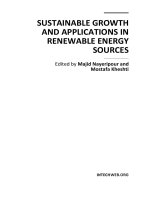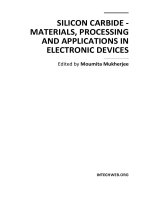Electromagnetic Waves Propagation in Complex Matter Part 1 ppt
Bạn đang xem bản rút gọn của tài liệu. Xem và tải ngay bản đầy đủ của tài liệu tại đây (547.45 KB, 20 trang )
ELECTROMAGNETIC
WAVESPROPAGATIONIN
COMPLEXMATTER
EditedbyAhmedA.Kishk
Electromagnetic Waves Propagation in Complex Matter
Edited by Ahmed A. Kishk
Published by InTech
Janeza Trdine 9, 51000 Rijeka, Croatia
Copyright © 2011 InTech
All chapters are Open Access articles distributed under the Creative Commons
Non Commercial Share Alike Attribution 3.0 license, which permits to copy,
distribute, transmit, and adapt the work in any medium, so long as the original
work is properly cited. After this work has been published by InTech, authors
have the right to republish it, in whole or part, in any publication of which they
are the author, and to make other personal use of the work. Any republication,
referencing or personal use of the work must explicitly identify the original source.
Statements and opinions expressed in the chapters are these of the individual contributors
and not necessarily those of the editors or publisher. No responsibility is accepted
for the accuracy of information contained in the published articles. The publisher
assumes no responsibility for any damage or injury to persons or property arising out
of the use of any materials, instructions, methods or ideas contained in the book.
Publishing Process Manager Iva Lipovic
Technical Editor Teodora Smiljanic
Cover Designer Jan Hyrat
Image Copyright Leigh Prather, 2010. Used under license from Shutterstock.com
First published June, 2011
Printed in Croatia
A free online edition of this book is available at www.intechopen.com
Additional hard copies can be obtained from
Electromagnetic Waves Propagation in Complex Matter, Edited by Ahmed A. Kishk
p. cm.
ISBN 978-953-307-445-0
free online editions of InTech
Books and Journals can be found at
www.intechopen.com
Contents
Preface IX
Part 1 Solutions of Maxwell's Equations
in Complex Matter 1
Chapter 1 The Generalized Solutions
of a System of Maxwell's Equations
for the Uniaxial Anisotropic Media 3
Seil Sautbekov
Chapter 2 Fundamental Problems
of the Electrodynamics of Heterogeneous Media
with Boundary Conditions Corresponding
to the Total-Current Continuity 25
N.N. Grinchik, O.P. Korogoda, M.S. Khomich,
S.V. Ivanova, V.I. Terechov
and Yu.N. Grinchik
Chapter 3 Nonlinear Propagation of
ElectromagneticWaves in Antiferromagnet 55
Xuan-Zhang Wang and Hua Li
Chapter 4 Quasi-planar Chiral Materials
for Microwave Frequencies 97
Ismael Barba, A.C.L. Cabeceira, A.J. García-Collado,
G.J. Molina-Cuberos, J. Margineda and J. Represa
Chapter 5 Electromagnetic Waves in Contaminated Soils 117
Arvin Farid, Akram N. Alshawabkeh
and Carey M. Rappaport
Part 2 Extended Einstein’s Field Equations
for Electromagnetism 155
Chapter 6 General Relativity Extended 157
Gregory L. Light
VI Contents
Part 3 High Frequency Techniques 185
Chapter 7 Field Estimation through Ray-
Tracing for Microwave Links 187
Ada Vittoria Bosisio
Chapter 8 High Frequency Techniques: the Physical
Optics Approximation and the Modified
Equivalent Current Approximation (MECA) 207
Javier Gutiérrez-Meana, José Á. Martínez-Lorenzo
and Fernando Las-Heras
Part 4 Propagation in Guided Media 231
Chapter 9 Electrodynamics of Multiconductor
Transmission-line Theory with Antenna Mode 233
Hiroshi Toki and Kenji Sato
Chapter 10 Propagation in Lossy Rectangular Waveguides 255
Kim Ho Yeap, Choy Yoong Tham,
Ghassan Yassin and Kee Choon Yeong
Part 5 Numerical Solutions based on Parallel Computations 273
Chapter 11 Optimization of Parallel FDTD Computations Based
on Program Macro Data Flow Graph Transformations 275
Adam Smyk
and Marek Tudruj
Preface
This book isbased on the contributions of several authors in electromagnetic waves
propagations.Severalissuesareconsidered.Thecontentsofmostofthechaptersare
highlighting non classic presentation of wave propagation and interaction with
matters.This bookbridges thegapbetweenphysics andengineeringintheseissues.
Eachchapterk
eepstheauthornotationthatthereadershouldbeawareofashereads
fromchapterto theother.Theauthor’snotations arekeptinordertoeliminate any
possibleunintentionalerrorsthatmightleadtoconfusion.Wewouldliketothankall
authorsfortheirexcellentcontributions.
Inchapter1,theproblemofradiationofar
bitrarilydistributedcurrentsinboundless
uniaxialanisotropicmediaisconsideredthroughthemethodofgeneralizedsolutions
ofthesystemofMaxwell’sequationsinanexactform.Thesolutionresolvesintotwo
independent solutions. The first corresponds to the isotropic solution for currents
directed along the cry
stal axi s, while the second corresponds to the anisotropic
solutionwhenthe currents are perpendiculartothe axis. The independentsolutions
define the corresponding polarization of electromagnetic waves. The generalized
solutions obtained in vector form by the fundamental solutions of the Maxwell’s
equationsarevalidforanyvaluesoftheelementsofthepermeabilitytensor,aswellas
for sources of the electromagnetic waves described by discontinuous and singular
functions.Thesolutionscanbealsorepresentedwiththehelpofvectorpotentialsby
the corresponding fundamental solutions. The problems for tensors of the dielectric
andmagneticpermeabilitiesareconsideredseparately.Inparticular,thesolu
tionsfor
elementaryelectricandmagneticdipoleshavebeendeduced.Throughtheuseofthe
expressionsforcurrentdensityofthepointmagneticandelectricdipolesusingdelta‐
functionrepresentations,theformulaefortheradiatedelectromagneticwaves,aswell
as the corresponding radiation patterns, are derived. The obtained solution in the
anisotropic case yi elds the well‐known solutions for the isotropic case as a limiting
case. The radiation patterns for Hertz radiator and point magnetic dipole are
represented. Directivitydiagramsofradiation of pointmagneticandelectricdipoles
areconstructedatparallelandperpendiculardirectionsofanaxisofacry
stal.Validity
of the solutions has been checked up on balance of energy by integration of energy
flow on sphere. The numerical calculation of the solution of Maxwell’s equations
shows that it satisfies the energy conservation law, i.e. the time average value of
X Preface
energy flux through the surface of a sphere with a point dipole pl aced at its center
remainsindependentoftheradiusofthesphere.Numericalcalculationshowsthatits
values keep with the high accuracy. The rigorous solving of system of Maxwell
equationsinananisotropicmediacanbeusedinconstructionoftheinteg
ralequations
forsolvingtheclassofrespectiveboundaryproblems.
In chapter 2, the consistent physic‐mathematical model of propagation of an
electromagneticwaveinaheterogeneousmediumisconstructedusingthegeneralized
wave equation and the Dirichlet theorem. Twelve conditions at the interfaces of
adjacentmediaareobtainedandju
stifiedwithoutusingasurfacechargeandsurface
current in explicitform.Theconditionsare fulfilled automaticallyin each section of
theheterogeneousmediumandareconjugate,whichmakeitpossibletousethrough‐
countingschemesforcalculations.Theeffectofconcentrationofʺmedium‐frequencyʺ
waveswithalengthoftheorderofhundredsofmetersatthefracturesandwedgesof
domains of size 1‐3μm is established. Numerical calculations of the total
electromagnetic energyonthe wedges ofdomainsareobtained. Itisshown thatthe
energydensityintheregionofwedgesismaximumandinsom
ecasesmayexertan
influenceonthemotion,sinks,andthesourceofdislocationsandvacanciesand,inthe
final run, improve the near‐surface layer of glass due to theʺmicromagnetoplasticʺ
effect. The results of these calculations are of special importance for medicine, in
particular,whenmicrowavesareus
edinthetherapyofvariousdiseases.Forasmall,
on the average,permissiblelev el ofelectromagnetic irradiation, the concentration of
electromagnetic energy in internal angular structures of a human body (cells,
membranes, neurons, interlacements of vessels, etc) is possible.A consistent
physicomathematicalmodelofinteractionofnonstationaryelectricandthermalfields
in a layered medium with allowance for mass transfer is constructed. The model is
basedonthemethodsofthermodynamicsandontheequationsofanelectromagnetic
field and is formulated without explicit separation of the charge carriers and the
chargeofanelectricdoublelayer.Therelationsfortheele
ctric‐fieldstrengthand the
temperature are obtained, which take into account the equality of the total currents
and the energy fluxes, to describe the electric and thermal phenomena in layered
media where the thickness of the electric double layer is small compared to the
dimensions of the object under study. The heating of an electrochemical cell with
allowancefortheinfluenceoftheelectricdoublelayeratthemetal‐electrolyteinterface
is numerically modeled. The calculation results are in satisfactory agreement with
experimentaldata.
Chapter3demonstratesthefabricationprocess,structure andmagnetic propertiesof
metal (alloy) coated ceno
sphere composites by heterogeneous precipitation thermal
reduction method to form metal‐coated core‐shell structural composites. These
compositescanbeappliedforadvancedfunctional materialssuchaselectromagnetic
waveabsorbingmaterials.
Preface XI
In chapter 4, a novel approach based on a periodic distribution of planar or quasi‐
planarchiralparticlesisproposedforthedesign ofartificialchiralmedia.Themetal
particles are replaced by dielectric ones, so that a high contrast between the
permittivity of the new dielectric particles and the host med
ium is achieved. This
approach would allow the design of materials with lower losses and more simply
scalableinfrequency.Bothapproachesarepresentedby dealing with the aspects of
design and realization of different “basic cells”. Numerical analysis in time and
frequency‐domain using commercial software program are used to treat the
propagation. Characterization of the medi
a and their propagation properties are
verifiedexperimentally.
Soilisacomplex,potentiallyheterogeneous,lossy,anddispersivematerial.Propaga‐
tionandscatteringofelectromagneticwavesin soilis, hence,morechallengingthan
air or other less complex media. Chapter 5 explains the fundamentals of m
odeling
electromagnetic wavepropagationand scattering insoilby solvingMaxwell’sequa‐
tionsusingafinitedifferencetimedomain(FDTD)model.Thechapterexplainshow
the lossy and dispersive soil medium (in both dry and water‐saturated conditions),
twodifferenttypesoftransmittingantennae(amonopoleandadipole),andrequired
absorbing boundary conditio
ns can be modeled. A sample problem is simulated to
demonstratethescatteringeffectsofadielectricanomalyinsoil.Thereafter,thedetails
aboutpreparationandconductofanexperimentalsimulationarediscussed.Thepre‐
cautionsnecessarytoperformarepeatableexperimentisexplainedindetailaswell.
Theresultsofthenu merically simulatedexampleis comparedandvalidatedagainst
experimentaldata.
InChapter6,Einsteinfieldequations(EFE)areextendedtoexplainelectromagnetism
by charge distributionsinlike manner, which should not be confused with the Ein‐
stein‐Maxwellequations,inwhichelectromagneticfieldsenergycontentswereadded
ontothoseasa
ttributedtothepresenceofmatter,toaccountforgravitationalmotions.
This chapter is substituting the termʺelectric chargeʺ for energy, and electromag‐
netism for gravity, i.e., a geometrization of the electromagnetic force. Einstein field
equationsdescribeonespace‐time,butinthischaptertwoareproposed:oneforʺpar‐
ticle
sʺ and the other forʺwaves;ʺ to wit, there are two gravitational constants.The
gravitational motions in aʺcombined space‐time 4‐manifoldʺ are unified.Also, the
readerfindsthatthechapterprovesthatelectromagneticfieldsasproducedbycharg‐
es,inanalogywithgravitationalfieldsasproducedbyenergies,causespace‐timecur‐
vatures,notbecauseoftheenergycontentsofthefieldsbutbecauseoftheCoulomb
potentialofthecharges.Asaresult,aspecialconstantofproportionalitybetweenan
electromagneticenergy‐momentumtensorandEinsteintensorarederived.
Inchapter7,araytracingapproachbasedontheJacob
i‐Hamiltoniantheoryisusedas
raysaredefinedbytheircharacteristicvectorandtheslowness(inverseofphaseveloc‐
ity)vectoralongtheray.Botharefunctionsoftheintegrationvariableandoftheinitial
conditions(launchingpointanddirection).ThecharacteristicvectorsatisfiestheHam‐
XII Preface
iltondifferentialequations.TheHamiltonianfunctiondescribesthewavepropagation
intheconsideredmedium.Raystrajectoriesarefunctionsoftheuniqueintegrationpa‐
rameter.Hamilton‐Jacobitheoryguaranteesthatthereisalwaysadomainofrepresen‐
tationinwhichsolutionsaremonodromefunctions.Here,thewavefrontsaremono‐
dromefunctionofthera
ylau
nchingangle.Amplitudeiscomputedthroughparaxial
rays.Causticsarisewhentherayfieldfolds.Theseeventsarecarefullyaccountedso
thatproperphaseshiftscanbeappliedtothefield.
Inchapter8,anoverviewofthewholeprocesstocomputeelectromagneticfieldlevels
basedonthehighfrequencytechniquemod
ifiedequivalentcurrentapproximationis
presented.Moreover, three new fast algorithms are briefly described to solve the
visibility problem. Those are used to complete a modified equivalent current
approximation.Theycanalsobehelpfulinotherdisciplinesofengineering.
Inchapter9,thefieldtheoryonelectrodynamicsandderi
veoftheMaxwellequation
and the Lorenz force are introduced. The multiconductor transmission‐line (MCTL)
equations for the TEM mode are developed. Solutions of the MCTL equations for a
normal mode without coupling to thecommon and antenna modes are provided as
wellasasolutionofoneantennasy
stemforem
issionandabsorptionofradiation.A
three‐conductortransmission‐linesystemandthe symmetrizationforthedecoupling
ofthenormalmodefromthecommonandantennamodesarediscussed.
Afundamentalandaccuratetechniquetocomputethepropagationconstantofwaves
inalossyrectangularwaveguideisproposedinchapter10.Theformulationis
based
onmatching thefieldstotheconstitutivepropertiesofthematerialattheboundary.
Theelectromagneticfieldsareusedinconjunctionoftheconceptofsurfaceimpedance
toderivetranscendentalequations,whose rootsgive valuesfor thewavenumbersin
the transverse directions of the waveguide axis for different transverse electric and
transverse magnetic modes. The new boundary‐matching method is validated by
comparing the attenuation of the dominant mode with the transmition coefficients
measurement,aswell asthatobtainedfrom thepower‐loss method.Theattenuation
curveplottedusingthenewmethodmatcheswiththepower‐lossmethodatareason‐
able range of frequencies ab
ove the cutoff. There are, however, two regions where
bothcu
rvesarefoundtodiffersignificantly.Atfrequenciesbelowthecutoff,thepow‐
er‐loss method diverges to infinity with a singularity at cutoff frequency. The new
method,however,showsthatthesignalincreasestoahighlyattenuatingmodeasthe
frequenciesdropbelowthecutoff.Suchresultagreesverycloselywiththemeasure‐
mentresult,therefore,verifyingthevalidityofthenewmethod.Atfrequenciesabove
100GHz,theattenuationobtained usingthenew methodincreasesbeyondthatpre‐
dicted
bythepower‐lossmethod. Atfrequencyabovethemillimeterwavelengths,the
fieldinalossywaveguidecannolongerbeapproximatedtothoseofthelosslesscase.
Theadditionallosspredictedbythenewboundary‐matchingmethodisattributedto
thepresenceofthelongitudinalelectricfieldcom
ponentinhybrid
modes.
Preface XIII
Chapter 11 is concerned with a numerical problem which can be solved by parallel
regular computations performed in points of a rectangular mesh that spans over
irregular computational areas. A hierarchical approach to the optimized program
macro data flow graph design for execution in parallel systems is presented. The
presented Re‐d
eployment with Connectivity‐
based Distributed Node Clustering
(RCDC)algorithmconsistsoftwoindependentmethodsforthefinitedifferencetime
domain (FDTD) data flow graph optimization: the cell re‐deployment and the
Connectivity‐based Distributed Node Clustering (CDC) algorithm. There are several
differencesbetweenthesetwomethods.Thefirstmethodisfullycentralizedandthe
macro data flo
w graph is created in three phases: computational area partitioning,
merging and re‐deployment. The CDC method is decentralized with only local
knowledgeofthesimulationarea.IntheRCDCalgorithm,bothmethodsaremerged
in order to obtain better parallel simulation speedup (comparable to the spee
dup
obtainedintheCDC)andto
shortentheexecutiontimeoftheoptimization.Itturned
out that such a hierarchical combination of the two algorithms has improved
partitioning of data flow graphs for the FDTD problem, and additionally, such
hierarchicaloptimizationtakessignificantlylesstimethantheCDCmethod.
AhmedA.Kishk
ProfessorDepartmentofElectricalandComputerEngineering
Tier1CanadaResearchChair,
Canada
Part 1
Solutions of Maxwell's Equations
in Complex Matter
0
The Generalized Solutions of a System of
Maxwell’s Equations for the Uniaxial
Anisotropic Media
Seil Sautbekov
Eurasian National University
Kazakhstan
1. Introduction
Media with anisotropic properties are widely used in modern radio electronics, an
astrophysics, and in plasma physics. Anisotropic materials have found wide application in the
microcircuits working on ultrahigh frequencies. Thin films from monocrystals are effectively
used as waveguide’s systems. At present, artificial anisotropic materials are especially actual
for the design of microwave integrated circuits and optical devices. The technology advances
are making the production of substrates, dielectric anisotropic films and anisotropic material
filling more and more convenient.
Due to the complexity caused by the parameter tensors, the plane wave expansion
(Born & Wolf, 1999) is often used in the analysis of anisotropic media. The standard
mathematical technique for treating propagation through a homogeneous anisotropic
medium is to investigate the independent time-harmonic plane wave solutions of Maxwell’s
equations. And consequently, the Fourier transform is widely applied (Chen, 1983; Kong,
1986; Ren, 1993; Uzunoglu et al., 1985).
The radiation field of a dipole in a anisotropic medium is considered in greater detail
and devised by (Bunkin, 1957; Clemmow, 1963a;b; Kogelnik & Motz, 1963). It is shown
(Clemmow, 1963a;b) that each such field is related by a simple scaling procedure to a
corresponding vacuum field. The vacuum field is expressed as the superposition of a
transverse magnetic field, in which the magnetic vector is everywhere perpendicular to the
axis of symmetry of the anisotropic medium, and a coplanar transverse electric field; and
different scaling is applied separately to each partial field. But because of the inevitable
complication of any such general analysis it also seemed desirable to isolate the simplest
non-trivial case.
Using these methods, (Uzunoglu et al., 1985) found the solution of the vector wave equation
in cylindrical coordinates for a gyroelectric medium. (Ren, 1993) continued that work for
spherical coordinates in a similar procedure and obtained spherical wave functions and
dyadic Green’s functions in gyroelectric media. The dyadic Green’s functions for various
kinds of anisotropic media with different structures have been studied by many authors
(Barkeshli, 1993; Cottis, 1995; Lee & Kong, 1983; Weiglhofer, 1990; 1993). The problems,
however, are mostly analyzed in spectral domain in terms of Fourier transform, due to the
1
2 Electromagnetic Waves
difficulty of finding the expansion of the dyadic Green’s functions in terms of vector wave
functions for anisotropic media. It shows the necessity of better characterizing the anisotropic
media and producing more realistic models for the components that use them.
The purpose of this chapter is to obtain explicit expressions for the stationary problem of
the field produced by a given distribution of external currents in an infinite homogeneous
uniaxial anisotropic medium without using the scaling procedure to a corresponding vacuum
field and the dyadic Green’s functions.
This chapter is organized as follows: in the following section, section 2, we present the
method of generalized function to solve the Maxwell’s equations for isotropic media. To
demonstrate the method we deduce the general solutions of Maxwell’s equations by means of
the unique Green’s function. Interrelation between the Green’s function and electrodynamic
potentials and also the Hertz potential is shown. Some forms of the Green’s function for
lower dimension are presented. In section 3, the method of generalized functions is employed
for solving the problem of uniaxial crystals. We introduce there a stationary electromagnetic
field (E, H)offrequencyω and formulate the problem. We use the generalized method of
the Fourier transformation for solving the matrix form of Maxwell’s equations. Radiation
of electric and magnetic dipole is considered and their directivity diagrams are obtained.
In section 4, we adduce all points of section 3 only for magnetic media. Finally, in section
5 conclusions and future related research are presented. In this chapter, we can note the
following main results. The fundamental solutions of a system of Maxwell’s equations for
uniaxial anisotropic media are obtained. Due to the fundamental solutions, general exact
expression of an electromagnetic field in boundless uniaxial crystal is obtained in the vector
type by the method of generalized functions. The results are valid for any values of the
elements of the permeability tensor, as well as for sources of the electromagnetic waves
described by discontinuous and singular functions. In particular, the solutions for elementary
electric and magnetic dipoles have been deduced. Through the use of the expressions for
current density of the point magnetic and electric dipoles using delta-function representations,
the formulae for the radiated electromagnetic waves, as well as the corresponding radiation
patterns, are derived. The obtained solution in the anisotropic case yields the well-known
solutions for the isotropic case as a limiting case. Validity of the solutions have been checked
up on balance of energy by integration of energy flow on sphere. The numerical calculation
of the solution of Maxwell’s equations shows that it satisfies the energy conservation law.
By means of the method of generalized functions it is possible to represent the electromagnetic
field in the integral form with respect to their values on an arbitrary closed surface.
Subsequently analytical solutions of Maxwell’s equations obtained in this chapter for
unbounded anisotropic media allow to construct the integral equations for solving the class of
corresponding boundary problems. The obtained solutions can be easily generalized taking
into account magnetic currents. Because electric and magnetic currents are independent, it
makes it possible to decompose a solution on separate independent solutions. The solutions
can be also represented with the help of vector potentials for the corresponding fundamental
solutions.
2. Method of generalized functions
To present the method of generalized functions (Alekseyeva & Sautbekov, 1999; 2000) we shall
consider stationary Maxwell’s equations for isotropic media
4
Electromagnetic Waves Propagation in Complex Matter
The Generalized Solutions of a System of Maxwell’s Equations for the Uniaxial Anisotropic Media 3
∇×H + iωD = j,
∇×E −iωB = 0.
(1)
The linear relation between the induction and the intensity of electric field in isotropic
dielectric mediums is:
D
= εε
0
E (2)
and the vector of magnetic induction is given by:
B
= μμ
0
H,(3)
μ, ε are the relative magnetic and dielectric permeability respectively, E and H are the intensity
of electric and magnetic fields respectively, and j is vector of current density.
We will present the system (1) in the matrix form:
MU
= J,(4)
where
M
=
iωε
0
εIG
0
G
0
−iωμ
0
μI
, G
0
=
⎛
⎝
0
−∂
z
∂
y
∂
z
0 −∂
x
−∂
y
∂
x
0
⎞
⎠
,(5)
U
=
E
H
, J
=
j
0
, E
=
⎛
⎝
E
x
E
y
E
z
⎞
⎠
, H
=
⎛
⎝
H
x
H
y
H
z
⎞
⎠
, j
=
⎛
⎝
j
x
j
y
j
z
⎞
⎠
, 0
=
⎛
⎝
0
0
0
⎞
⎠
,(6)
ω is the constant frequency of electromagnetic field, M is Maxwell’s operator, I is a identity
matrix 3
×3.
A method generalized functions based on the theory of the generalized function of the Fourier
transformation is used for solving the matrix equation (4) (Vladimirov, 2002):
˜
E
(k)=F[E(r)] =
R
3
E(r)exp(−ikr)dV (7)
where
E
(r)=F
−1
[
˜
E
(k)] =
R
3
˜
E
(k)exp(ikr)
d
3
k
(2π)
3
,(8)
k
=(k
x
, k
y
, k
z
), d
3
k = dk
x
k
y
k
z
, dV = dxdydz, r =(x, y, z).
By means of direct Fourier transformation we will write down the system of equations (1) or
(4) in matrix form:
˜
M
˜
U
=
˜
J,(9)
˜
M
=
iε
0
εωI
˜
G
0
˜
G
0
−iμ
0
μωI
,
˜
G
0
= i
⎛
⎝
0
−k
z
k
y
k
z
0 −k
x
−k
y
k
x
0
⎞
⎠
. (10)
The solution of the problem is reduced to determination of the system of the linear algebraic
equations relative to Fourier-components of the fields, where
˜
U is defined by means of inverse
5
The Generalized Solutions
of a System of Maxwell’s Equations for the Uniaxial Anisotropic Media
4 Electromagnetic Waves
matrix
˜
M
−1
:
˜
U
=
˜
M
−1
˜
J. (11)
By introducing new function according to
˜
ψ
0
=
1
k
2
0
−k
2
, (12)
we define the inverse matrix:
˜
M
−1
=
˜
ψ
0
−( ε
0
ε)
−1
˜
G
1
−
˜
G
0
−
˜
G
0
(μ
0
μ)
−1
˜
G
1
, (13)
where
˜
G
1
=
1
iω
⎛
⎝
k
2
1
−k
2
0
k
1
k
2
k
1
k
3
k
1
k
2
k
2
2
−k
2
0
k
2
k
3
k
1
k
3
k
2
k
3
k
2
3
−k
2
0
⎞
⎠
, (14)
k
0
≡ ω
√
ε
0
εμ
0
μ, k
2
= k
2
x
+ k
2
y
+ k
2
z
. (15)
By considering the inverse Fourier transformation
M
−1
= F
−1
[
˜
M
−1
], J = F
−1
[
˜
J
], U = F
−1
[
˜
U
] (16)
and using the property of convolution:
F
−1
[
˜
M
−1
˜
J
]=M
−1
∗J, (17)
where symbol "
∗" denotes the convolution on coordinates x, y, z, it is possible to get the
solution of the Maxwell equations (4) as:
U
= M
−1
∗J, (18)
where
M
−1
=
−( ε
0
ε)
−1
G
1
−G
0
−G
0
(μ
0
μ)
−1
G
1
ψ
0
, G
1
=
−
1
iω
⎛
⎜
⎜
⎝
∂
2
∂x
2
+ k
2
0
∂
2
∂x∂y
∂
2
∂x∂z
∂
2
∂x∂y
∂
2
∂y
2
+ k
2
0
∂
2
∂y∂z
∂
2
∂x∂z
∂
2
∂y∂z
∂
2
∂z
2
+ k
2
0
⎞
⎟
⎟
⎠
(19)
or
E
H
=
(iε
0
εω)
−1
(∇∇+ k
2
0
)(j ∗ψ
0
)
−∇×(
j ∗ψ
0
)
=
(ε
0
ε)
−1
∇ρ ∗ψ
0
−iμ
0
μωψ
0
∗j
j
×∗∇ψ
0
, (20)
according to the charge conservation low
j −iωρ = 0. (21)
Here ρ is charge density, ψ
0
is the Green’s function or a fundamental solution of the Helmholtz
operator for isotropic medium (Vladimirov, 2002):
ψ
0
= F
−1
[
˜
ψ
0
]=−
1
4π
e
ik
0
r
r
, r
=
x
2
+ y
2
+ z
2
(22)
6
Electromagnetic Waves Propagation in Complex Matter









